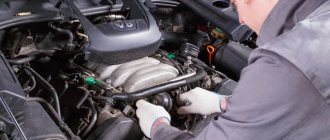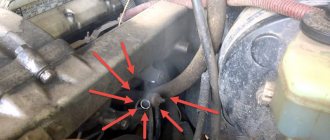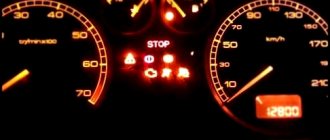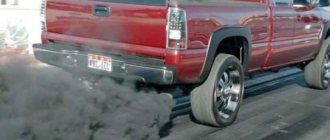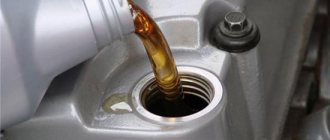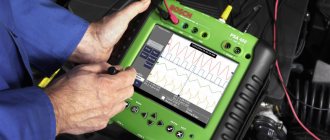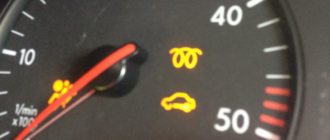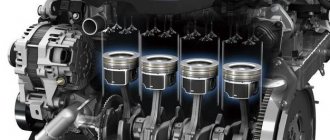Diesel engine breathlessness: causes and how to eliminate
Before answering the question: “Why is the engine breathing?”, it is necessary to understand what exactly is meant by this formulation.
As a rule, this phrase characterizes the manifestation of excess gases in a power plant. Characteristic signs of this phenomenon can be considered smoke from the neck where oil is poured, leakage of working lubricant in various parts of the engine (breather, seals, etc.). Oddly enough, if the engine starts to breathe, it’s too early to talk about any breakdown; you need to figure out what the reason is, since this phenomenon can manifest itself not only in units with high mileage, but also in completely new units, both gasoline and diesel
The breather is a special valve-type device designed to equalize the pressure inside the crankcase of the power plant with the ambient pressure. The process is quite simple: when pressure rises above atmospheric pressure, the valve opens and releases excess vapors to the outside, thereby ventilating the crankcase and removing gases.
Reasons why oil leaks through the breather, gaskets and seals
When the breather is heavily clogged, such high pressure is created in the sub-piston space that oil can be squeezed out of the crankcase even through the inspection hole for the dipstick, oil seals and engine gaskets. Therefore, at the first sign of a malfunction, it is necessary to establish the reasons for the release of oil through the breather. The main problems and their consequences are listed in the table below.
| Cause of oil release | Why is this happening | Consequences |
| Critical wear of the piston rings, less often burnout of the valve or piston | Gases from the combustion chamber break into the sub-piston space. The ventilation system cannot cope with the increased volume. | A drop in compression, a noticeable decrease in engine power, difficulty starting, tripping, oil squeezing out through the seals. |
| Wear of valve stem seals | Excess oil enters the combustion chamber and the piston ring grooves become clogged. Due to the loose fit of the valves to the seats, gases penetrate into the space above the valve, creating excess pressure and disrupting the operation of the crankcase ventilation system. | Increased oil consumption, carbon formation on valve plates and seats, oiling of spark plugs, burnout of valves, accelerated wear of piston rings. |
| Oil deflector clogged | Due to the blockage, the oil particles contained in the crankcase gases are not separated, as a result of which they, along with vapors, enter the intake. | Oiling of the air filter, carburetor jets, throttle valve, deterioration of engine performance due to a violation of the air-fuel mixture. |
| Clogged breather pipe | Oil is released along with crankcase gases as a result of an increase in pressure in the crankcase due to the inability to discharge it through the breather. | Squeezing oil through the dipstick hole, pan gasket, crankshaft oil seal and other seals. It is possible for the pipe to break off from the breather outlet or for gases to penetrate through cracks formed in it. |
| Failed breather valve | Due to the jamming of the valve, pressure does not release when it increases above permissible limits. | Oil squeezing out through seals due to a non-working ventilation system, tripping, deterioration of engine performance due to excess pressure in the sub-piston space. |
| Clogged air filter | Due to the reduced filter capacity, suction occurs along with oil particles from the crankcase ventilation system. | Oiling of carburetor jets, throttle valve (in injection models), violation of the composition of the air-fuel mixture. |
| Oil level exceeded | Excess oil along with gases enters the breather, and the oil separator cannot cope with their removal. | Rapid clogging of the oil separator, formation of oil clots in the hose, and its entry into the intake manifold. |
Why does crankcase pressure increase?
Having noticed oil leaks in the engine compartment and/or a decrease in the oil level in the crankcase, it is necessary to accurately determine that the diesel engine is breathing. This can be done in the following way. It is enough to unscrew the oil filler cap on a warm diesel engine. If you notice bluish smoke coming from the throat, then the problem is obvious.
Cylinder piston group and cylinder head
The main reason that a diesel engine is breathing is the wear of the cylinder-piston group. During the operation of the internal combustion engine, scuffs form on the cylinder walls, the cylinders themselves gradually break and acquire a changed shape of the walls, and the piston rings wear out or break. As a result of heating, the thermal gaps between the piston and the cylinder walls become too large.
If the diesel engine is very worn out, then a major overhaul is necessary, which will mean boring the cylinders, replacing pistons, rings, etc. Accurate diagnosis of CPG problems requires measuring compression to determine the spread of indicators across the cylinders.
In the event that the diesel engine does not breathe much and the malfunction is only at the initial stage (wear of the cylinder walls is within acceptable limits), some auto mechanics resort to the method of decarbonizing the piston rings. This measure is considered temporary, since further long-term operation of the unit after decarbonization of the rings should not be expected. The best solution would be to replace the rings with new ones.
A diesel engine can also vent due to wear of valves, guide bushings, valve seals, etc. Similar to piston malfunctions and ring decarbonization, timing problems can only be effectively eliminated by comprehensive repairs. Replacing valve seals alone does not have a lasting effect.
Engine crankcase ventilation system
Second on the list of main reasons why a diesel engine is breathing is a clogged crankcase ventilation system. The symptoms of a decrease in the throughput of this system resemble wear of the CPG: increased consumption of engine oil, diesel smoking with blue smoke, etc. In some cases, it is possible to normalize engine operation and eliminate excess oil consumption by cleaning the breathers.
Causes of malfunction
There may be several reasons, the main ones being:
- Contamination and failure of the crankcase ventilation system;
- Malfunctions of the cylinder-piston group;
- Damage to the cylinder head.
To accurately determine what exactly led to the uncharacteristic behavior, it is necessary to diagnose the state of the power plant with the involvement of specialists.
Crankcase ventilation
The unpleasantness and danger of the phenomenon lies in the fact that the user is not always able to identify signs of uncharacteristic behavior in time. As a result, a neglected problem can lead to serious consequences and make the situation much worse.
When the crankcase ventilation stops working, it does not release excess pressure into the atmosphere, but accumulates it inside the crankcase of the power plant. Over time, when the pressure reaches a critical point, the accumulated gases are released through the filter.
As a rule, this phenomenon is accompanied by a loud bang. The worst case scenario can lead to serious damage to engine parts.
In order to avoid troubles and not aggravate them by breakdown, at the first sign of a malfunction of the ventilation system and breather, it is necessary to wash them as quickly as possible. Troubleshooting can be done in two simple ways: disassemble the breather and wash all the necessary parts and the filter from deposits, or add a special detergent additive to the oil, which will eliminate all dirty formations.
Piston rings
One of the reasons that the power plant is breathing may be a problem with the piston rings. During engine operation, some of the exhaust gases leak into the engine crankcase. Over time, the pressure increases, and they begin to look for a way out of the confined space. Due to the fact that the ventilation system is clogged, gases begin to escape from all possible cracks in the seals and seals.
Failure of the rings leads to an increase in pressure in the crankcase, and this in turn leads to an excess of oil consumption. Some part of it is squeezed out through the dipstick, some through the seals, forming a leak. Some oil, through loosely fitting rings, enters the working chamber and burns out there along with the fuel.
Sometimes all these symptoms are accompanied by a flashing light on the car’s dashboard, signaling a breakdown in the engine. To confirm the diagnosis, it is necessary to measure the compression of the power unit. Compression of less than 11 units in any cylinder, together with other phenomena, indicates the occurrence of rings. To eliminate the malfunction, it is necessary to disassemble the unit and carry out repairs.
When carrying out repairs, disassemble the pistons and conduct a full diagnosis of the rings. If they occur, it is necessary to remove the rings; the procedure must be performed with special care, so as not to break the parts. After removal, the rings and pistons must be completely cleaned of carbon and deposits; special attention must be paid to the grooves; the corrosion that has formed in them must be completely eliminated.
After replacing the pistons and rings after cleaning, you need to make sure that there is no play between the surface of the cylinder and the rings. Otherwise, the rings will need to be replaced with new ones.
Cylinder-piston group
If the check shows no problems with the crankcase ventilation and rings, the next common possible cause may be damage to the cylinder liner surfaces. To eliminate the defect, it is necessary to grind the surfaces and install new rings of the repair size. If the cylinders are worn heavily, engine boring cannot be avoided.
The engine may bleed due to wear of valves, seals, bushings, etc. In any case, an accurate diagnosis and elimination of the cause requires a complete diagnosis and inspection of the motor by a specialist.
Source
The engine smokes: White smoke.
Additive Suprotek Active Plus Gasoline for gasoline engines
Additive for gasoline and gas engines with a mileage of more than 50,000 km. Can be used for forced and turbocharged engines.
Additive Suprotek Active Plus Gasoline for gasoline engines
Additive for gasoline and gas engines with a mileage of more than 50,000 km. Can be used for forced and turbocharged engines.
If steam is visible in warm weather and on a well-warmed-up engine, this may be due to coolant getting into the cylinders. Its shade depends on the composition of the coolant, weather, lighting and the amount of coolant in the combustion chamber. Sometimes it can acquire a bluish tint and resemble “oil” smoke. But unlike oil smoke, which leaves a bluish haze in the air for a long time, steam dissipates quickly. It is difficult for a person without sufficient experience to determine by appearance what is actually the source of the smoke, so you can use the “old-fashioned” method of checking. To do this, on a well-warmed engine, it is necessary to briefly cover the cut of the exhaust pipe with a sheet of white paper; condensed steam in the form of water droplets, when it hits the paper, will gradually evaporate and will not leave obvious greasy marks. If this simple test confirms that it is steam and not oil smoke coming out of the exhaust system, it is necessary to take measures to eliminate the malfunction that allows coolant to penetrate the cylinders.
Engine additive "Suprotek Active Standard"
For naturally aspirated petrol engines up to 1.6 litres. Restores and equalizes compression, reduces fuel and oil consumption due to waste, protects friction surfaces in the CPG and gas distribution mechanism from wear during startup and overheating.
Fluid in cylinders
Most often, liquid can enter the cylinders through the head gasket due to insufficient traction (in winter, coolant leakage is often observed at the junction of the block and head), burnout, and less often as a result of the formation of microcracks in the head or cylinder block. In addition, these defects cause exhaust gases to enter the cooling system, forming gas plugs, which is guaranteed to indicate a malfunction.
When you open the radiator cap or expansion tank, you can easily notice the smell of exhaust gases and a film of oil on the surface of the coolant. And the fluid level will be low. It is typical that in such cases, after starting a cold engine, the pressure in the cooling system increases, increasing the level of coolant in the expansion tank. Moreover, this level is unstable and you can notice the release of gas bubbles in the tank, sometimes with periodic release of coolant from the tank.
When the engine is stopped, the picture changes. Liquid begins to flow into the cylinder. Gradually it passes through the piston rings and enters the oil, into the oil pan. Upon subsequent startup, the oil and liquid are mixed, forming an emulsion and changing color - it acquires a matte tint and becomes lighter. Circulating through the lubrication system, such an emulsion leaves a characteristic light yellow-brown foam on the valve cover and oil filler plug.
If the defect (crack, burnout) is small, then there may not be any changes (it happens that the oil remains clean, although foam forms on the plug and valve cover). In case of very large damage, liquid can accumulate above the piston, preventing the starter from rotating the crankshaft at the time of starting; in especially severe cases, water hammer in the cylinder, deformation and breakage of the connecting rod are possible.
In areas where it enters the cylinder, the coolant actively cleans carbon deposits, including from the spark plugs, and this helps determine the location of the damage. A complete check will require dismantling the cylinder head to assess the condition of the gasket, head and block planes.
It also happens that coolant enters the cylinder through the intake system - for example, due to a leak in the intake manifold gasket (if it simultaneously seals the manifold cooling channels with coolant). In such cases, the pressure in the cooling system does not increase, there is no smell of exhaust gases, but the oil turns into an emulsion, and the coolant level quickly decreases. These signs, as a rule, are enough to find the defect and not confuse it with the one described above, otherwise the cylinder head will be removed in vain.
steaming from the breather, the reason?
Questions can only be asked after registration. Please login or register.
steaming from the breather, what could it be? and is it possible to work like this?
steaming from the breather, what could it be? and is it possible to work like this?
It’s possible, but it will consume a lot of oil, it’s better to make the engine
hard physical labor in the fresh air makes a person brutish and angry
steaming from the breather, what could it be? and is it possible to work like this?
It’s possible, but it will consume a lot of oil, it’s better to make the engine
but it floats, that is, water vapor.
steaming from the breather, what could it be? and is it possible to work like this?
It’s possible, but it will consume a lot of oil, it’s better to make the engine
but it floats, that is, water vapor.
Most likely, there is a coolant leak (antifreeze, water) at the junction of the liner with the cylinder block.
steaming from the breather, what could it be? and is it possible to work like this?
It’s possible, but it will consume a lot of oil, it’s better to make the engine
but it floats, that is, water vapor.
Most likely, there is a coolant leak (antifreeze, water) at the junction of the liner with the cylinder block.
and what to do? what to do?
Or maybe a gasket
Or maybe a gasket
The gasket is new, just warmed up and that's it. I don't think it's that fast. and by the way, it also hovers into the crankcase (
steaming from the breather, what could it be? and is it possible to work like this?
It’s possible, but it will consume a lot of oil, it’s better to make the engine
but it floats, that is, water vapor.
Most likely, there is a coolant leak (antifreeze, water) at the junction of the liner with the cylinder block.
and what to do? what to do?
Remove the pan, and then carefully inspect all the cylinder walls (especially the lower part), you can place a sheet of paper, this also helps with diagnostics. The cooling system must be filled at this time.
but it floats, that is, water vapor.
If water is poured in, the oil will be white, if antifreeze is added, the oil will not change, the level will simply increase. You tell me what it is that floats. If water or antifreeze gets into the pan, it will definitely knock. Steam cannot escape from the vent and the oil remains clean and undiluted
hard physical labor in the fresh air makes a person brutish and angry
but it floats, that is, water vapor.
If water is poured in, the oil will be white, if antifreeze is added, the oil will not change, the level will simply increase. You tell me what it is that floats. If water or antifreeze gets into the pan, it will definitely knock. Steam cannot escape from the vent and the oil remains clean and undiluted
water is flooded. Today I drained the oil, took an iron mug, put it on gas and brought it to a boil, it steams. took it, added it, mixed 1 liter of oil with 1 liter of water, it mixed into a homogeneous mass ((((I don’t understand what it is at all(
water is flooded. Today I drained the oil, took an iron mug, put it on gas and brought it to a boil, it steams. took it, added it, mixed 1 liter of oil with 1 liter of water, it mixed into a homogeneous mass ((((I don’t understand what it is at all(
Oil steams when heated, and this is correct, but it cannot mix with water. If you just mix, you will see splashes of water, if you pass it through a pump, then there will be an emulsion and the oil will become the color of coffee with milk
hard physical labor in the fresh air makes a person brutish and angry
Source
Features of diagnostics and repair of the Cummins ISF 3.8 engine
Experts systematized their experience in repairing ISF 3.8 and talked about when car owners should contact the workshop.
The yellow “check” lights up
The reason may be
- low-quality fuel;
- decrease in oil level;
- electrical wiring faults.
To determine the source of the problem, it is necessary to conduct a thorough engine diagnosis.
Insufficient boost pressure
This malfunction is manifested by loss of traction and smoke emissions when pressing the gas pedal. This is due to:
- damage to the turbine impeller;
- increased play and damage to the turbine valve;
- a burst intercooler pipe and its leakage;
- poor condition of the exhaust system, that is, insufficient exhaust pressure.
It is necessary to identify errors in the operation of a car using special equipment available in service centers.
Gas pedal malfunction
The problem may be manifested by the following symptoms: “twitching” while driving, lack of response to pedal pressure and a lit check. The main reasons may be
- pedal sensor contamination;
- oxidation of its contacts.
PetroMotors specialists will help you find out what’s wrong.
Malfunction of the exhaust cooler or USR valve
Here are the most obvious signs of this problem:
- white smoke comes from the chimney;
- traction decreases and power decreases;
- antifreeze quickly leaves the cooling system.
The most accessible methods for eliminating such a malfunction are installing plugs on the cooler and valve and flashing the engine to EURO-3.
Errors when changing oil
After carrying out the standard oil change procedure, do not tighten the pan plug too tightly. A force of 24N*M will be quite enough to tighten it and maintain the tightness of the connection. If the threads on the drain plug have been stripped, it is recommended to install a new plug.
Oil release from breather
There may be several reasons for such an outlier. The most harmless of them is low-quality oil or exceeding its level. To eliminate the problem, it is enough to change the oil or drain excess oil.
Another, more serious cause of emissions may be wear of the piston rings, which is a consequence of engine overheating or “dust wear.” After replacing the piston group and lining the cylinder block, the situation returns to normal.
Timely detection of the problem eliminates serious breakdowns and unnecessary waste. PetroMotors specialists will diagnose the engine and troubleshoot problems.
Why does oil flow through the breather?
Symptoms of a clogged breather include oiling of the outer surface of the cylinder block in the area of the pipe leading from the crankcase and the oil dipstick, the air filter housing or the throttle valve. Typically, this problem occurs due to untimely maintenance of the crankcase ventilation system or when the engine intensively ejects oil through the breather. The latter may be a sign of serious problems , including critical wear of parts of the cylinder-piston and valve groups.
Leakage due to simple clogging of the pipe and oil separator is also dangerous, as it leads to disruption of the engine lubrication system. We will talk about all the main consequences and causes of oil release from the breather and ways to prevent this phenomenon in this article.
to “Smoke coming from the exhaust pipe - gray, blue, white, black smoke from the exhaust pipe”
A very useful article, definitely bookmark it, you should especially pay attention to the exhaust when you buy a car. If there is smoke, then avoid this vehicle.
It is difficult to determine the condition of the engine by the color of the smoke. My friend Moskvich has walked more than 100 thousand. Frankly, it is still unknown how it smokes. In the morning, cold engine - steam visible to the naked eye, closed the garage and drove off. I never warm up the engine. The rings are untouched and does not take oil. But we do chemicals regularly. We tried any serious additives. Determining seriousness by intuition. The fuel consumption of the new car remains the same. As for mechanical instruments, I use IKS to adjust the carburetor.
All visual diagnostics of the car’s condition based on the color of the smoke from the exhaust pipe are perfectly described. It may not be a 100% hit, but still the hint of a “diagnosis” is real. And by taking advantage of this, you can prevent the “disease” by carrying out a preventive check and the necessary adjustments.
Steam from the exhaust pipe should not always be ignored; if in cold weather it can somehow be explained, then when it is warm and such steam appears, then this indicates coolant leaks to the cylinders, and, therefore, it will be necessary to check the piston cuffs and rings, which are not maintain the tightness of the block. And also the formation of black smoke may not indicate any serious malfunctions, but only bad fuel, this is especially often noticeable in diesel cars.
In addition, you need to know that domestic cars “eat oil,” i.e. it simply gets into the fuel system and this is considered the norm, but on modern foreign cars this is not the case, the amount of oil you fill will be the same in a year. Therefore, the presence of oil in the engine and, accordingly, bluish-white smoke coming from the pipe, for domestic cars does not indicate a malfunction. I'm not even talking about the color of the smoke when you pour break-in oil into the car, which can be such a burnt color that I think even a showroom car will have a special smoke with it.
no, it’s not true, my VAZ 2103 hasn’t used a drop of oil in half a year
Alexey, I don’t believe that the VAZ troika can avoid eating butter. In order to reduce oil consumption, you need to at least overhaul the engine, change all the rings, pistons, cylinder block gaskets, and then I don’t think it will be possible to completely eliminate its consumption. And to measure the amount of oil at its minimum consumption, you can only completely drain the old one from the system, wash it and only then fill in new one, and after half a year, as you say, drain the oil again and see its quantity, but just know that it’s still in some part of it will remain in the system, so the statement that supposedly “not a drop of oil has been lost in half a year” is not true, or do you have some kind of ultra-precise measurement method. How did you measure? You certainly can’t tell by looking at the oil dipstick if it has decreased by 50 grams. Perhaps you simply did not correctly calculate the amount when you filled in new oil, did not take into account that there was also a certain amount of old oil left in the system, and you ended up with zero consumption.
The article warns and gives basic concepts on how to identify a malfunction. But judging by the reviews, everyone is super specialist, and VAZ can’t help but “eat” oil, and a foreign car is the limit of perfection - read the instructions for your foreign cars and the theory of internal combustion engines, after which you will stop being clever and writing nonsense. Thanks to all.
The information is useful but not fully described. There is such a thing as a car does not smoke, but sometimes it smokes with a bluish tint. The culprit in such a situation is worn out valve seals. This happens when the car brakes with the engine, at this time ignition does not occur, the oil collects in the cylinders and, if necessary, the driver presses the gas pedal, there is a short-term combustion of oil and fuel and we see a cloud of blue smoke released, then it all disappears and the car works normally. mode. or smoke may appear from excess pressure in the engine, which the dead valve seals are not able to cope with, this happens most often on long climbs.
The article is informative and useful. I can tell you how to get rid of the white cloud of smoke that appears due to water in the muffler. Everything can be done in a garage within ten minutes.
You will need: 1. Drill 2. Drill with a diameter of 3mm.
You need to visually mark the lowest point of your muffler and drill a hole there. All the moisture that previously collected in the muffler and created a large white cloud of smoke will flow out through this hole. Thanks to this hole, you will not only get rid of smoke, but also double the life of the muffler. The inside of the muffler will be constantly dry - therefore, corrosion will not develop.
By the way, the domestic auto industry used to make these technological holes in production. Then they stopped and started making good money selling new mufflers. I have been driving every day for six years on one muffler with a hole. A muffler without a hole lasted me a maximum of two years. And lastly, the hole does not affect the exhaust sound in any way.
I’ll give you some advice right away regarding the smoke from the exhaust pipe. The main thing to remember is that if you notice that thick black smoke is coming out of the exhaust pipe, then you shouldn’t panic right away! The reason may lie in the fuel itself, as correctly noted in the material above. Just let the car drive with this fuel. This is how you need to behave calmly, provided, of course, that you don’t notice any other faults with the car :-). And now, if after you refuel for the second time from another gas station, thick black smoke comes out again, then contact a car service center. There is no need to try to dig into this problem yourself, spend more effort and time, my advice to you. By the way, this has already happened to me twice this year. I fill up at one of the roadside gas stations of an unknown company and sometimes such a problem with smoke begins!
Symptoms
The first, main symptoms that a diesel engine has begun to breathe are lubricant leaks and a decrease in the oil level in the crankcase. Having noticed such characteristic phenomena, it is necessary to make sure that the suspicions are correct. To do this, you need to warm up the engine to operating temperature, unscrew the oil filler cap and check for bluish smoke.
If suspicions are confirmed and smoke is present, the diagnosis is obvious. Let's try to figure out why the diesel engine is breathing and how to fix it.
Blue smoke
Gray or blue smoke pours out of the exhaust pipe in a dense stream when a large amount of oil burns along with the fuel. Oil is constantly consumed in the engine, it is wasted in small doses, and each manufacturer has standards for oil consumption. At these standards, no smoke is observed from the exhaust pipe. But as soon as the car starts eating buckets of oil, that’s when blue smoke appears.
Oil can be consumed for several reasons:
- problems with rings (cylinder-piston group)
- leakage in the valves - oil enters through the valve stem seals or through the valve head-valve guide interface
- through the turbine, if it is a turbocharged engine
These are the main reasons, but some combinations are possible, combinations when the oil comes in a different way. For example, the breather may become clogged and crankcase gases will increase, breaking into the combustion chamber, or something else may become clogged, but these are quite rare cases.
The problems described above, in addition to the turbine, can only be dealt with by disassembling the engine and looking inside. The oil seals are visible under the valve cover, and if they are in order, then the problem must be looked for deeper by removing the cylinder head. In any case, the head must be removed, since it is impossible to change the caps on a head that has not been removed normally, unless with the help of special equipment.
The turbine is easier to diagnose; just remove the air duct pipe from it and see if there is oil in it. Oil, as a rule, flows from there in a stream.
Also, seasonal-gray smoke can come from a terrible overconsumption of fuel, when the injectors are overfilled, and an incorrectly set ignition also helps them throw unburned fuel into the pipe. Well, the stench of burning is worth it!
Why does oil come out through the breather?
A small amount of oil getting into the breather is not a sign of a problem . One of the functions of this unit is precisely the separation of suspended oil particles contained in crankcase gases and their return to the engine. The main purpose of the breather is to relieve excess pressure in the sub-piston space of the cylinder block by diverting a mixture of water and fuel vapors into the intake manifold.
Breather in the crankcase ventilation system
To make it easier to understand why oil is driven through the breather or dipstick, let’s briefly analyze the design and operating principle of the crankcase ventilation system.
The design may vary slightly depending on the model , but it always includes three main elements - a housing, an oil separator (oil slinger) and one or two pipes. In some cars, the breather is additionally equipped with a valve that opens when a certain pressure in the crankcase or vacuum in the intake is reached.
The flexible hose can connect the crankcase outlet to the intake manifold, engine air filter housing and carburetor (directly through the filter housing or valve cover) or the air hose in front of the throttle body. The oil deflector can be placed in the breather body, in a separate housing, or under the valve cover if the air outlet into the intake is organized from under it.
Additionally, the function of an oil trap is performed by a flame arrester built into the pipe in the form of a spiral wire or mesh.
The general operating principle of all systems is the same: crankcase gases enter the combustion chamber directly through the intake or carburetor, and the oil they contain enters under the valve cover or into the crankcase.
Oil in the intake manifold entered through the breather
Oil trap clogged with sludge
If the ventilation system does not function correctly, the volume of crankcase gases or the content of oil particles in them is too high, the engine throws out oil through the breather in excess, it is not completely separated by the oil deflector and enters the intake manifold and carburetor along with the gases.
White smoke appears
Most often, white smoke appears from under the hood, or, to be more precise, steam, which is mistaken for smoke by inexperienced motorists. There are many reasons why it occurs:
- Coolant boiling. When the engine has warmed up to such a state that the coolant has boiled, it is highly likely that you will have to look for funds for a major overhaul of the engine. There are more than enough reasons for antifreeze to boil, and there is only one sign of this - the appearance of white smoke from the engine compartment.
- Cooling radiator leakage. In this case, a small part of the antifreeze falls on the outer wall of the radiator and instantly evaporates, turning into white smoke.
- Violation of the tightness of the pipes . It often happens that if the pipes are damaged or the clamp is loose, antifreeze begins to drip onto the exhaust manifold. When it hits it, it also instantly evaporates. Faulty radiator cap or expansion tank. This leads to a violation of the tightness and, naturally, to the ingress of coolant onto hot parts of the car.
The mistaking of antifreeze vapors for smoke is quite understandable - various additives used to improve the performance of the coolant emit a very specific odor during evaporation, which is mistakenly mistaken by inexperienced drivers for the smell of burnt electrical wiring or plastic.
A situation often occurs when white smoke appears only when the engine is running, and when the engine is stopped it stops coming. Numerous attempts to determine the source of its appearance will not be successful. The fact is that you need to look for a coolant leak only on a cold engine - with a hot engine it will simply evaporate instantly, and it will be simply impossible to determine the location of the leaks.
Engine troubles
Everyone has heard this word “triple”. But not everyone fully understands what this word means. But this term was coined precisely in our country to designate a common problem. The fact is that sometimes one of the cylinders in the engine begins to malfunction or completely stops working. The mixture of air and fuel in it either burns poorly or does not burn at all. As a result, only three working cylinders remain. Hence the word “triple”.
The driver understands that this problem has arisen by how much the engine begins to vibrate. There is a feeling that he is ready to break free of his fastenings. In this case, the car does not move. Sometimes you can hear fuel flashes that pop into the muffler.
If the VAZ 2106 is tripping, there may be three reasons for this:
Less or more air enters the cylinder than necessary. This may be due to loss of air tightness in the air system. We check whether the system is leaking air somewhere. To do this, use a compressor to pump air into the system to increase the pressure and listen to where it hisses. If there is no hissing, then the system is still sealed. You also need to check if the air filter is clogged. The air supply dampers may also be faulty.
Particular attention should be paid to the throttle valve. More or less fuel enters the cylinder than necessary. This is checked by measuring the pressure in the fuel system
If the pressure is low, you need to look for a problem in the fuel pump and in the pressure valve. If the pressure is normal, you need to diagnose the injectors for contamination or failure. Low compression. If this is the reason, then you need to prepare yourself for a long, expensive repair. Compression is reduced or reset if the piston burns out, the piston wheel wears out, or the valve malfunctions. To find out the true cause, you will have to completely disassemble the engine and troubleshoot it. Often you have to do major repairs.
